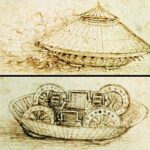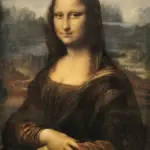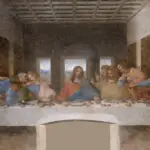
by Dukgyu | Apr 29, 2025 | Renaissance

Medici family facts often seem complex and hard to remember. This guide will help clear things up if you feel overwhelmed by names, dates, and stories.
You will discover clear and interesting facts about the Medici family that make their history easy to follow.
The Medici family shaped Florence and much of Europe for centuries. Their story connects art, politics, science, and religion in surprising ways.
These facts shine a light on why the Medici are still studied and admired today.
1. The Medici family originated as merchants from the Mugello region north of Florence.
The Medici family began as merchants in the fertile Mugello region, just north of Florence, Italy. Their roots in trade and commerce laid the groundwork for the wealth that fueled their influence over Florence during the Renaissance’s peak.
Initially, the Medici were simple traders and bankers, rather than nobles. Over time, their banking empire expanded, granting them the power and resources to influence the culture and politics of Florence.
Their commercial success helped the Medici family gain respect. And they influenced, building strategic alliances through marriage and becoming a leading political dynasty.
This foundation was crucial for their later roles as patrons of the arts, science, and architecture that defined Renaissance Florence.
2. They established the Medici Bank, once Europe’s most powerful financial institution.
The Medici Bank stood at the center of Renaissance Florence, Italy. Giovanni di Bicci de’ Medici founded it in 1397, and it became a crucial component in the family’s ascent to power.
The bank gained fame for its wealth, meticulous management, and strong family leadership. Under Cosimo the Elder, the bank expanded across Europe, opening branches in key cities such as Rome, Venice, and London.
The Medici gained influence, and their extensive banking network helped them become rulers of Florence and major patrons of the arts and sciences. The Medici Bank’s success enabled the family to support artists such as Michelangelo and Leonardo da Vinci.
Their support shaped Renaissance culture and left a legacy that is still evident in Florence today. The Medici dynasty set the standard for banking and patronage in Europe.
3. Cosimo de’ Medici was the first to consolidate Medici power in Florence.
Cosimo de’ Medici transformed the Medici family from a wealthy banking family into a powerful political dynasty in Florence, Italy. As head of the Medici Bank, he expanded its reach and increased the family’s wealth.
He built alliances with other nobles and politicians, gaining great influence in Renaissance Florence. Cosimo used his position to shape the government and culture of the city.
He became a strong patron of the arts by supporting artists, architects, and scholars. This support helped Florence become a center for art and learning.
Cosimo de’ Medici’s leadership set the stage for later family members, including Lorenzo the Magnificent. His efforts established the Medici as rulers of Florence and central figures in Italian history.
4. The Medici ruled Florence for approximately 300 years during the Renaissance.
The Medici ruled Florence for around 300 years. Their rise to power began in the late 13th century and lasted until the 18th century.
During this period, Florence emerged as one of the most significant cultural centers in Europe. The Medici family began as bankers, utilizing the Medici Bank to accumulate wealth and exert political influence.
With their wealth, they supported artists such as Michelangelo, Leonardo da Vinci, and Botticelli, fueling a burst of creativity known as the Renaissance. This political dynasty acted as patrons of art, science, and learning.
Medici support helped build landmarks like the Florence Cathedral dome and fund public works and architecture that defined the city.
5. They were not hereditary nobles but rose to power through finance and politics.
The Medici family did not start as hereditary nobles. Instead, this powerful dynasty in Florence, Italy, built its wealth and influence through banking and trade during the Renaissance.
The Medici Bank became one of the most successful financial institutions in Europe. This banking empire provided the family with the wealth and influence to gain political control over Florence.
Using their wealth, they influenced government decisions and formed strategic alliances through marriage. Their rise demonstrated that financial acumen and political savvy could be just as crucial as noble birth in gaining power in Renaissance Florence.
6. Giovanni di Bicci de’ Medici founded the Medici Bank in the late 14th century.
Giovanni di Bicci de’ Medici founded the famous Medici Bank in 1397 in Florence, Italy. This move marked the beginning of the economic rise of the Medici family and laid the groundwork for their enduring political dynasty.
At the time, Florence was one of the busiest cities in Europe for trade and banking. The Medici Bank became the largest and most respected bank in Europe during the 1400s, thanks to wise management and strong family ties.
This brought great wealth and influence to the Medici family. The success of the Medici Bank contributed significantly to the flourishing of arts, science, and architecture in Renaissance Florence.
It helped the family become rulers of Florence and influential patrons of the arts and culture.
7. The family pioneered the development of formal rules and contracts for banking and lending.
The Medici family set new standards for banking in Renaissance Florence. They created the Medici Bank, which became the most respected financial institution in Europe at the time.
Before the Medici, Italian banking lacked official guidelines and clear systems. The Medici family introduced written rules and formal contracts for bank loans, thereby changing the way people conducted business.
Their system helped build trust among clients and encouraged more people to use banks. These changes gave the Medici dynasty even more power in politics and economics.
Their approach to banking had a profound influence on systems across Europe and played a significant role in the growth and prosperity of Renaissance Florence.
8. Lorenzo de’ Medici, known as ‘Lorenzo the Magnificent’, was a major patron of Renaissance art.
Lorenzo the Magnificent stood out as a leading figure in the Medici political dynasty. He ruled Florence, Italy, and played a pivotal role in shaping its cultural transformation during the Renaissance.
He supported many artists, poets, and scholars. Famous artists such as Michelangelo and Botticelli gained their start thanks to Lorenzo’s generous patronage.
His funding and encouragement helped make Florence a center for art and learning. Lorenzo’s influence can still be seen in Renaissance art and architecture across Florence.
The Medici family’s wealth from banking enabled it to sponsor painters, sculptors, and architects, transforming the city’s appearance and spirit. His support for public works, libraries, and collections helped build a lasting legacy of creativity and education.
9. The Medici family crest, featuring balls called ‘palle’, is visible throughout Florence.
The Medici family crest, marked by its iconic red balls known as “palle,” appears on buildings, churches, and monuments throughout Florence. This shield features five red balls and one blue ball, and became a strong symbol of the Medici dynasty’s influence and wealth during the Renaissance.
Many historians believe the balls on the Medici coat of arms may represent coins, a reminder of the family’s success in banking and finance. Their banking empire helped the family become rulers of Florence and patrons of the arts.
Visitors to Florence will notice these symbols in important sites such as palaces, public buildings, and especially the Medici Chapel. The crest remains a lasting testament to the Medici family’s enduring influence on the art, architecture, and culture of Renaissance Florence.
10. They famously supported artists including Michelangelo, Leonardo da Vinci, and Botticelli.
The Medici family’s patronage played a significant role in shaping the artistic scene of Renaissance Florence. They leveraged their financial wealth and political influence to support brilliant artists such as Michelangelo, Leonardo da Vinci, and Botticelli.
Michelangelo lived under the care of Lorenzo the Magnificent and was treated almost as a member of the Medici family. Leonardo da Vinci also benefited from their network, as he began his education through their circle of patrons.
The Medici encouraged artists to explore new styles and themes, thereby pushing the boundaries of Italian art. Their assistance led to some of the most famous works in Western culture.
This strong tradition of supporting artists ensured a lasting legacy, making the House of Medici central to Florence’s cultural transformation.
11. The Medici bank’s peak made the family one of the wealthiest in Europe during the 15th century.
The Medici Bank became a powerhouse in Renaissance Florence, Italy. Its success gave the Medici family enormous wealth and made them key players in European politics.
At its height, experts consider the bank the largest and most respected in Europe. This prosperity led to the rise of the Medici dynasty.
With their growing riches, the family supported artists, scientists, and architects. They became important patrons of the Renaissance, helping to transform the city’s culture.
The bank’s success also contributed to the Medici family’s rise as powerful rulers of Florence. Their influence shaped the city’s art, politics, and society for many years.
12. They played a crucial role in the cultural and political development of the Italian Renaissance.
The Medici family shaped Renaissance Florence, Italy, through their wealth and political influence. They transformed Florence into a center of art, culture, and science by supporting artists such as Michelangelo, Leonardo da Vinci, and Botticelli.
Their banking empire provided the funds that drove these cultural changes. As patrons of the Renaissance, the Medici also supported architects, funded public works, and contributed to the creation of iconic sites, such as the Florence Cathedral dome.
Their support expanded beyond art. They fostered science and promoted education, making Florence famous across Europe for its progress.
Politically, the Medici rose from bankers to rulers of Florence, becoming a leading dynasty in the region. They used marriages, alliances, and strategic moves to gain power and influence Italian politics for centuries.
13. The Medici family initially made their fortune through wool trading before transitioning into banking.
The Medici family first amassed wealth through the wool trade in Florence, Italy. Their work as merchants gave them an early taste of prosperity and influence.
Wool was a vital part of the city’s economy, and the family’s skill in this industry helped them build valuable alliances. With this new wealth, the dynasty expanded its activities into banking.
The profits from wool commerce enabled them to establish the renowned Medici Bank. This transition from commerce to banking marked a turning point in the Medici family’s political power.
Their financial influence gave them access to leading families and rulers of Florence. This helped them become a key part of the Italian Renaissance and laid the groundwork for their legacy.
14. Several Popes emerged from the Medici family, such as Pope Leo X and Pope Clement VII.
The Medici family became deeply involved in the politics and religion of Renaissance Florence. Their rise to power extended beyond banking, reaching into the very heart of the Catholic Church.
Four members of this influential dynasty served as popes: Leo X, Clement VII, Pius IV, and Leo XI. Individuals such as Pope Leo X and Pope Clement VII played significant roles in Church history and European politics.
Their connection to the church increased the Medici family’s influence. This helped them secure alliances with many rulers and noble families across Europe.
15. Their patronage helped establish Florence as a central hub of European art and culture.
The Medici family’s patronage marked a turning point for Renaissance Florence. Using their wealth from banking, they invested in art, science, and public works that transformed the city’s cultural landscape.
Their support brought some of the most talented artists and thinkers to Florence, including Michelangelo and Leonardo da Vinci. Cosimo the Elder and Lorenzo the Magnificent, two key figures of the dynasty, utilized their power and influence to support significant projects and innovative minds.
The Medici played a significant role in the construction of landmarks such as the Florence Cathedral dome and the renowned Uffizi Gallery art collection. By funding artists and scholars, the Medici played a direct role in shaping Renaissance culture across Europe.
16. The Medici never initially held formal hereditary nobility titles, relying instead on influence.
The Medici family did not initially hold formal noble titles. Instead, they built power in Renaissance Florence through their wealth, the Medici Bank, and strong political influence.
They used their position as bankers and supporters of the arts to gain respect in society. This approach enabled them to become a leading political dynasty in Italy, despite lacking the legal rights and status of the old nobility.
Their influence stemmed from alliances, public works, and the patronage of artists such as Michelangelo and Leonardo da Vinci. The Medici made strategic marriages and contributed to Florence’s cultural transformation long before receiving any official noble titles.
17. After the main family line ended, Tuscany’s rule passed to the Duke of Lorraine.
The Medici political dynasty in Florence came to a close in 1737. When Gian Gastone de’ Medici died without an heir, the House of Medici lost its hold on power and influence in Italy.
Tuscany then passed into the hands of the Duke of Lorraine, marking a new chapter in its government and culture. Anna Maria Luisa de’ Medici, the last of her line, helped ensure many Medici art collections stayed in Florence after her death through an important agreement known as the Family Pact.
18. They financed the construction of iconic Florence landmarks, including the Uffizi Gallery.
The Medici family utilized their banking empire to influence the development of the city of Florence, Italy. Their wealth and power allowed them to support impressive public works and architecture, leaving a permanent mark on Renaissance Florence.
One of their most famous contributions was funding the Uffizi Gallery. At first, this building served as offices for magistrates, but it later became home to the Medici’s priceless art collections.
The Uffizi now stands as a key museum in the city and is closely connected to the Medici legacy. The Medici family’s role as patrons of the arts attracted artists like Michelangelo and Botticelli, ensuring Florence’s place as a center of creativity and culture.
19. The Medici utilized marriage alliances to strengthen political ties across Europe.
The Medici family used strategic marriages to expand their political power far beyond Florence, Italy. These alliances enabled the Medici to forge connections with other noble and royal families across Europe.
Many members of the Medici family married into royalty, which enhanced their standing and ensured their prosperity. For example, two Medici women became queens of France, thereby establishing a direct connection to the French throne and furthering their legacy as a powerful ruling house.
The Medici also arranged marriages with other influential Italians and European families. These relationships added even more strength to their political network, thereby increasing their influence during the Renaissance’s peak.
20. The Medici Bank ultimately declined due to mismanagement and political conflicts.
The Medici Bank once stood as a symbol of prosperity and influence in Renaissance Florence, Italy. Its wealth gave the Medici family the power to shape both local and European politics.
However, the bank’s success did not last. Financial mismanagement, risky loans, and growing debts damaged its stability.
Disagreements within the family exacerbated existing problems, leading to further decline. Political conflicts in Florence and across Italy made it even harder for the Medici Bank to recover.
The loss of public trust and support weakened the family’s control over the city. By the late 1400s, the Medici Bank had lost its power, marking the end of an important era in Florentine banking history.
Frequently Asked Questions
The Medici family was renowned for their long-standing rule over Florence and their influential banking empire. Their influence shaped art, politics, and even religion during the Renaissance.
What are three facts about the Medici family?
The Medici family came from a merchant background in the Mugello region near Florence. They created the Medici Bank, which was once the most influential bank in Europe.
The family produced four popes and played a significant role in launching the Renaissance through their support of artists and thinkers.
What was the dark side of the Medici family?
The Medici family frequently employed bribery, manipulation, and violence to maintain its power. Some members arranged for the assassinations of rivals to retain control of Florence.
Corruption and political plotting were prevalent, resulting in numerous enemies and conspiracies against them.
Are there any Medicis alive today?
The main Medici family line ended in the 1700s. There are no direct descendants left today.
Other people with the Medici last name may exist, but they are not part of the famous ruling family. The previous official Medici ruler was Anna Maria Luisa de’ Medici.
How did the Medici family end?
Anna Maria Luisa de’ Medici died in 1743 without children. After her death, another family assumed leadership of Florence through European treaties.
The family fortune and art collections became public property in Florence.
Why was the Medici family so powerful?
The Medici became extremely wealthy through banking, which enabled them to exert significant influence over politics in Florence. They used their money to support the arts and make alliances.
They placed family members in important positions, including four popes. Their financial and political skills enabled them to spread their influence across Europe.
How much would the Medici be worth today?
The Medici fortune was one of the largest in Renaissance Europe. By today’s standards, their wealth could compare to that of modern billionaires.
Much of their wealth was tied to land, gold, and artwork, making it difficult to provide a precise figure.
Why was the Medici family corrupt?
Many members of the Medici family used bribery and political corruption to maintain their power. They interfered with elections and used their bank to gain an advantage over their rivals.
This led to accusations of dishonesty and widespread public distrust throughout their rule.
Who was the most loved Medici?
Lorenzo de’ Medici, also known as Lorenzo the Magnificent, is often regarded as the most beloved member. He supported artists like Michelangelo and Botticelli.
Many people in Florence respected him for maintaining peace in the city during his rule.
Who was the most powerful family in Italy?
During the Renaissance, the Medici family was the most powerful in Florence and one of the top families in Italy. Other vital families included the Sforza in Milan and the Borgia in Rome.
The Medici’s banking and political control set them apart from other dynasties.
What is the Medici Palace used for today?
The Medici Palace, also known as Palazzo Medici Riccardi, now functions as a museum. It is open to the public.
The museum displays art exhibits. Visitors can explore and learn about Renaissance history.
The building still shows the power and style of the Medici family in Florence.

by Dukgyu | Apr 29, 2025 | Renaissance
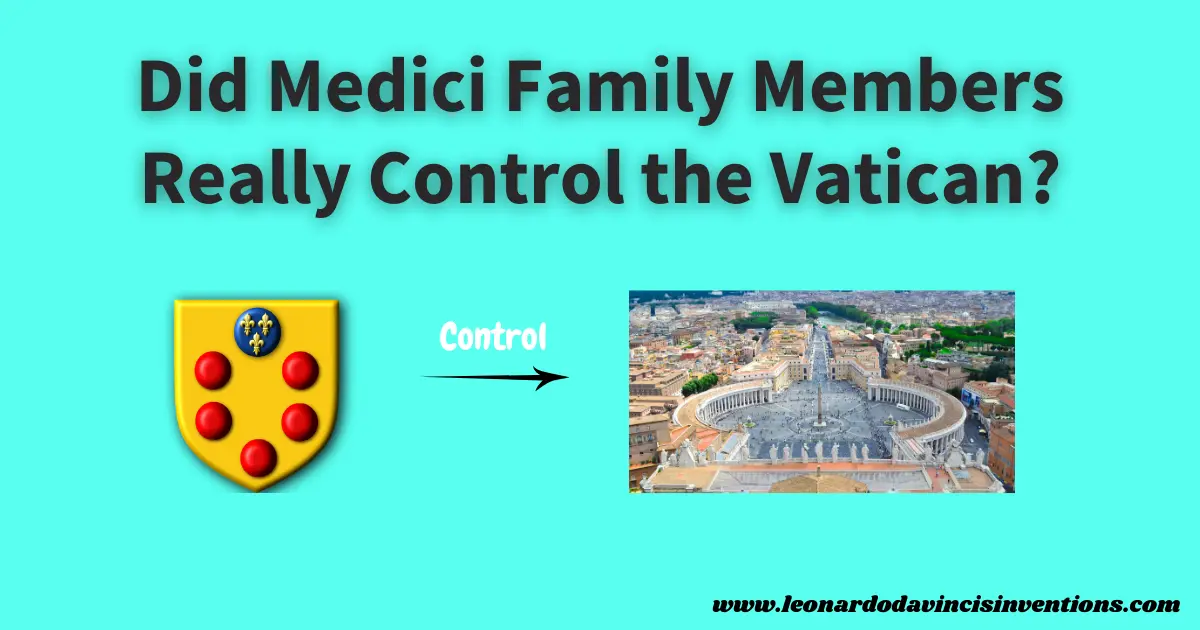
The Medici family has often been associated with the Vatican’s history, leaving many people uncertain about the extent of their influence over the Catholic Church.
You might wonder how this famous family used their power. If you’re confused about the facts or stories you’ve heard, you’re not alone.
This article will help you understand what happened and reveal the actual connection between the Medici family and the Vatican.
The Medici family did not control the Vatican, but they did produce four popes who played significant roles in the church’s leadership and politics.
Members like Leo X and Clement VII played a significant role in shaping both religious and political decisions. Yet, they still operated within the larger framework of the Catholic Church, rather than as absolute rulers.
Their time in power reveals how families and faith could mix in Renaissance Italy.
Through their wealth and political skill, the Medici family became one of the most powerful families in Europe.
They married into royal families and held important jobs in Florence and beyond.
If you’re interested in how Cosimo de’ Medici, Lorenzo de’ Medici, Leo X, and Catherine de’ Medici influenced their time, understanding their relationship with the Vatican adds a new layer to their legacy.
The Rise of Medici Family Members in the Catholic Church
The Medici family’s journey from banking in Florence to power within the Catholic Church changed both religious and political life in Europe.
Their legacy of political intrigue, artistic patronage, and papal leadership shaped the course of the Italian Renaissance.
Cosimo de’ Medici and the Foundation of Medici Power in Florence
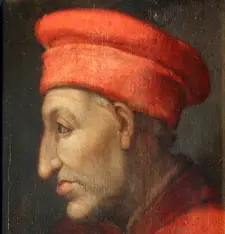
Cosimo de’ Medici (1389-1464)
Cosimo de’ Medici, also known as Cosimo the Elder, established the Medici dynasty as rulers of Florence during the 15th century.
He used the wealth of the Medici Bank to support public works and intellectual life in Florence.
He became renowned for his patronage of Renaissance art and architecture, commissioning notable buildings such as the Palazzo Medici Riccardi and supporting prominent scholars and artists.
His political strategies and alliances allowed the Medici family to dominate the Florentine government.
Cosimo built influence not only through wealth but also by placing loyal supporters in key positions.
Under his leadership, Florence flourished as a center of banking, culture, and science.
Medici Bloodline: From Banking Family to Papal Influence
The Medici bloodline gradually expanded its reach from banking into the realm of religion.
Marriage alliances and loyal connections helped the Medici family establish connections with influential positions in the Church.
Their financial support for the Papacy strengthened their ties in Rome.
By the late 1400s, Medici descendants had become bishops and cardinals.
Their wealth and political power were essential in securing these roles.
The Medici’s involvement in papal elections and Church politics eventually set the stage for family members to claim the papal throne themselves.
Their growing influence in the Catholic Church soon extended far beyond Florence, as seen in the Medici family history.
Papacy Connections: Pope Leo X, Pope Clement VII, and Medici Descendants
Two members of the Medici family became popes: Pope Leo X (born Giovanni de’ Medici) and Pope Clement VII (born Giulio de’ Medici).
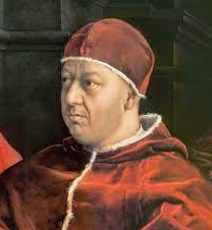
Pope Leo X (1475-1521)
Leo X guided the Church during the early years of the Protestant Reformation and was known for his love of the arts and support of great thinkers.
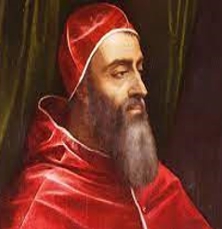
Pope Clement VII (1478-1534)
Clement VII faced a crisis during the Sack of Rome in 1527.
These Medici popes helped to extend their family’s religious influence and further tie Florence to Rome.
Their papal reigns marked the height of Medici influence in the Vatican and cemented the Medici dynasty as a force within the Catholic Church.
Medici Family Members’ Political Power and Influence in the Vatican
The Medici family’s ties to the Vatican shaped European history.
Their members rose to the papacy, bringing the wealth, art, and politics of Florence into Catholic leadership.
Their mix of banking power, personal alliances, and strategic marriages secured significant influence inside the Church.
Patronage, Political Intrigue, and the Medici Dynasty’s Control
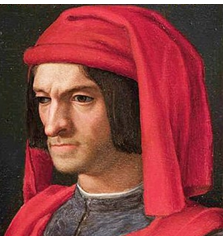
Lorenzo_de_Medici (1449-1492)
The House of Medici rose to prominence as a banking family in Florence, accumulating sufficient wealth to sponsor artists and influence politics.
Cosimo de’ Medici and Lorenzo de’ Medici used art sponsorship and patronage to win support among the elite.
Their family ties helped secure the election of two Medici popes: Pope Leo X and Pope Clement VII.
Medici popes directed Church policy, appointed family members to key positions, and used papal power to strengthen their dynasty.
The Medici dynasty’s involvement in controversies, including conspiracies and political intrigue, made them both admired and feared throughout Europe.
Their use of power led to artistic growth during the Italian Renaissance, with Florence becoming a cultural and religious hub for the Catholic Church.
Medici Exile, Restoration, and Legacy in the Catholic Church
The fortunes of the Medici family shifted over time, marked by dramatic exiles and restorations.
During periods of Medici exile, Florence experienced political upheaval and instability.
Upon their return, Medici rulers reasserted their dominance in both secular and religious spheres.
The legacy of the Medici influence is still felt today.
Anna Maria Luisa de’ Medici, the last of the line, secured the family’s art collection for Florence, making collections like those in the Uffizi Gallery accessible to the public.
Their impact on the Vatican is evident in their patronage of Renaissance art, promotion of church reforms, and even policies that affected rulers across Europe.
Rulers of Florence: How the Medici Dynasty Shaped the Papacy
As rulers of Florence, the Medici shaped many papal decisions.
By supporting the careers of future cardinals and popes—often relatives—they molded the political environment of the Catholic Church.
Their banking empire funded major Church projects, including the building of St. Peter’s Basilica.
With Pope Leo X and Clement VII, Medici ideals influenced Vatican art, education, and religious policy.
Family ties allowed them to influence the Medici interests in Church governance.
Their approach to rulership blended Florence’s humanism with the priorities of the Papacy.
Cultural Legacy and Controversies of the Medici Family Members
The Medici family shaped Florence’s political, social, and cultural landscape for centuries.
Their reputation includes achievements in art and power struggles that led to scandal and decline.
Renaissance Art, Patron of the Arts, and the Uffizi Gallery
The Medici dynasty played a central role in the Italian Renaissance.
Cosimo de’ Medici transformed Florence into a hub for humanism and culture, supporting artists such as Fra Angelico and Donatello.
Lorenzo de’ Medici, known as “il Magnifico,” sponsored Michelangelo, Botticelli, and Leonardo da Vinci, boosting their creative work.
They founded libraries, collected books, and sparked scientific interest.
Their patronage led to landmarks such as the Medici Chapel and the Florence Cathedral’s dome.
The family’s art collection, preserved by Medici descendants, formed the core of the Uffizi Gallery, one of the world’s most renowned museums.
Scandalous Affairs, Conspiracies, and Family Feuds in the Medici Genealogy
Family feuds and rivalries often plagued the Medici bloodline.
Assassinations and plots marked their rule, most notably the attempted murder of Lorenzo de’ Medici and the killing of Giuliano de’ Medici during the Pazzi Conspiracy.
Medici family members faced repeated exiles, betrayals, and the return of power.
Some ruled as Dukes of Florence and Grand Dukes of Tuscany.
The dynasty’s reach extended to the Catholic Church, with Giovanni de’ Medici becoming Pope Leo X and Giulio de’ Medici becoming Pope Clement VII.
Their political power garnered admiration, but also drew frequent allegations of corruption and scandalous affairs.
The Fall of the Medici: Extinction of the Medici Line and Anna Maria Luisa’s Legacy
The Medici Bank, once a symbol of economic power, collapsed due to financial mismanagement.
By the 18th century, the Medici bloodline faded as family members died out.
Anna Maria Luisa de’ Medici, the last of her line, secured much of the Medici art for Florence before her death.
With her act, she ensured that the Medici cultural legacy would remain in the public domain.
This allowed Florence to retain its treasures, including works in the Uffizi Gallery, thereby strengthening the city’s identity as a center of art and history long after the House of Medici came to an end.
Frequently Asked Questions
The Medici family significantly influenced Renaissance Florence and played a pivotal role in European history.
Many questions remain about their wealth, power, and the fate of their dynasty.
Are there any Medici families today?
There are no direct male Medici descendants alive today.
The main Medici line died out in the 1700s, and the family name no longer continues through the original bloodline.
Some people may claim a distant connection, but the historic Medici family is considered extinct.
Who inherited the Medici fortune?
After the last Medici ruler, Anna Maria Luisa de’ Medici, died, much of the family’s wealth and art collection was left to the city of Florence.
She signed a pact that kept the Medici treasures in Florence for public enjoyment, ensuring their legacy lived on locally.
Who was the most famous member of the Medici family?
Lorenzo de’ Medici, known as “Lorenzo the Magnificent,” stands out as the most famous member of the Medici family.
He led Florence during its cultural heyday and supported artists such as Michelangelo and Botticelli.
Cosimo de’ Medici and Catherine de’ Medici are also well-known for their influence in both politics and culture.
Why did the Medici family fall?
The Medici lost power through political struggles, expensive wars, and a lack of strong heirs in their later generations.
Other powerful families and shifting European politics made it difficult for the Medicis to maintain control of Florence.
What was the dark side of the Medici family?
The Medici family was sometimes involved in bribery, corruption, and political murder.
They worked behind the scenes to manipulate Florentine politics and were known for suppressing enemies.
Some Medici popes were also criticized for their wealth and questionable choices.
How did the Medicis lose their money?
The family’s wealth declined because they overspent and made poor loan decisions. Later, the Medici generations struggled to manage the banking empire. The famous Medici Bank collapsed, which reduced the family’s fortune.
Why did the Medici bloodline end?
The last official Medici, Anna Maria Luisa, died in 1743 without children. Years of intermarriage and the lack of male heirs ended the family line.
How much would the Medici be worth today?
If we adjust their wealth to today’s value, the Medici family would be worth billions of dollars. Their banking empire, land holdings, and art collection made them some of the wealthiest people in Renaissance Europe.
Which Medici died of syphilis?
Alessandro de’ Medici, the first Duke of Florence, is believed to have died from assassination. Some reports say syphilis contributed to his health problems. Syphilis was common among European royals in the 1500s and sometimes affected powerful families.
Are there any living descendants of Mary, Queen of Scots?
Mary, Queen of Scots, has living descendants, but not through the Medici family. Her lineage continued through her son, King James VI and I.
This line leads to the British royal family. The Medicis did not marry directly into Mary’s bloodline.
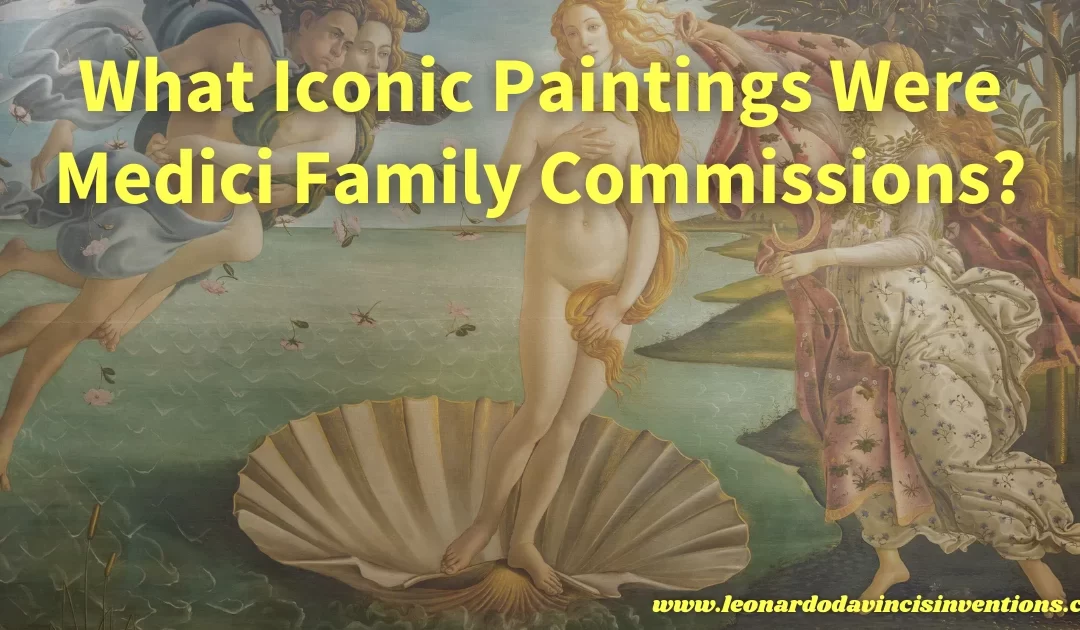
by Dukgyu | Apr 28, 2025 | Renaissance
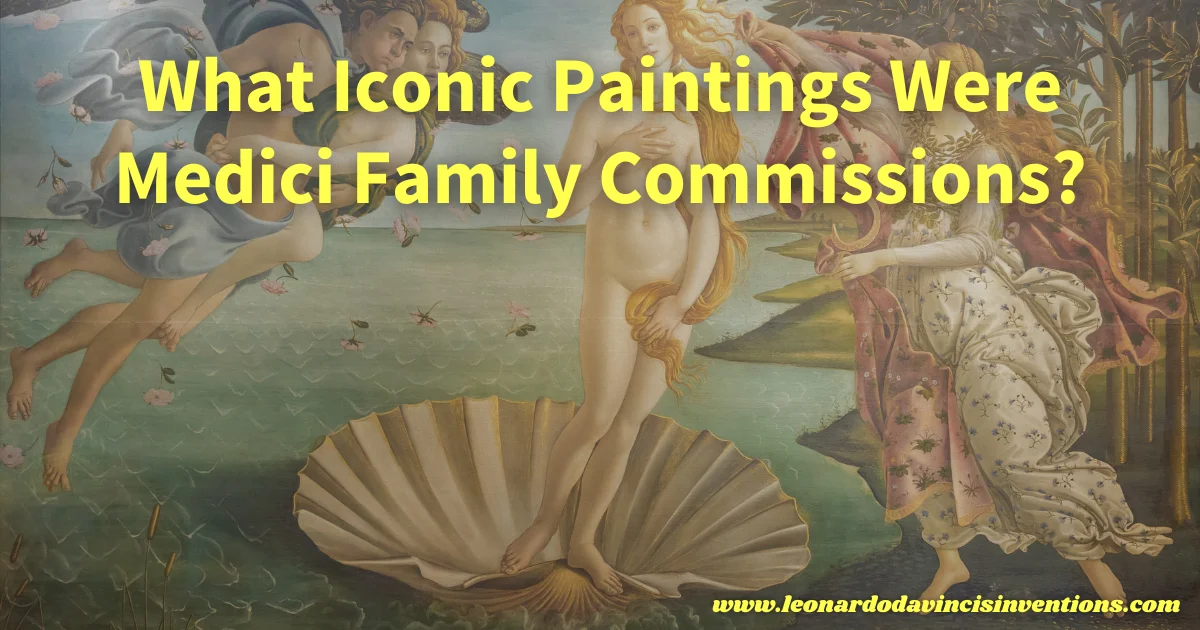
Medici family painting commissions had a profound influence on the development of Renaissance art and a lasting impact on culture.
Many people want to know which iconic works came to life through the family’s support, but this information can seem overwhelming or hard to find. This article will guide you through the masterpieces created because of the Medici family and highlight the stories behind each work.
Some of the most famous paintings ever made, such as Botticelli’s The Birth of Venus and Donatello’s David, were directly commissioned or financed by the Medici family.
These works defined the Renaissance style and influenced artists and their styles for generations.
These commissions connected influential artists, such as Botticelli and Michelangelo, with the Medicis, making Florence a hub of artistic achievement.
Knowing which paintings the Medici commissioned provides valuable insight into art history and reveals the family’s enduring legacy.
The Medici Family’s Patronage and Its Impact on Renaissance Art
The Medici family commissions shaped the art and culture of Renaissance Florence. By supporting talented artists, the Medici family sparked innovation and left a lasting legacy through celebrated artworks.
How the Medici Family Painting Shaped the Florence Art Scene
The Medici family held enormous influence over art in Florence. Their support enabled painters such as Botticelli, Leonardo da Vinci, and Michelangelo to concentrate on their creative projects, resulting in some of the most renowned masterpieces in art history.
Their commissions included both religious and secular themes. This support enabled artists to experiment with new styles and techniques, thereby setting artistic trends in Florence.
Medici patronage played a pivotal role in the emergence of the Renaissance and the city’s rich artistic heritage.
The Role of Wealth and Power in the Medici Family Commissions
The Medici’s rise as a banking and political dynasty gave them extraordinary wealth and power. This allowed them to act as collectors and major sponsors of the arts.
With their ability to commission large-scale works, the family directed artistic talent toward projects that displayed their power, values, and emblems. They transformed their palaces and public spaces with artworks, including portraits, frescoes, and sculptures, using art to showcase both their devotion and status.
Their investment in art became a model for other noble families and fueled demand for new creativity across Florence and beyond.
Patron-Artist Relationships and the Rise of Renaissance Masterpieces
Artists benefited from close ties with Medici patrons. These relationships provided stability, resources, and opportunities to experiment with techniques and subjects.
The Medici family’s commissions inspired projects like Botticelli’s Birth of Venus, now regarded as a symbol of Florence’s artistic legacy and innovation in art.
Workshops thrived, and artisans pushed the limits of what art could show, from humanist ideas to detailed symbolism. The Medici’s support turned talented artists into legends and established Florence as a center for celebrated masterpieces throughout the Renaissance.
Iconic Medici Family Paintings and Their Legacy
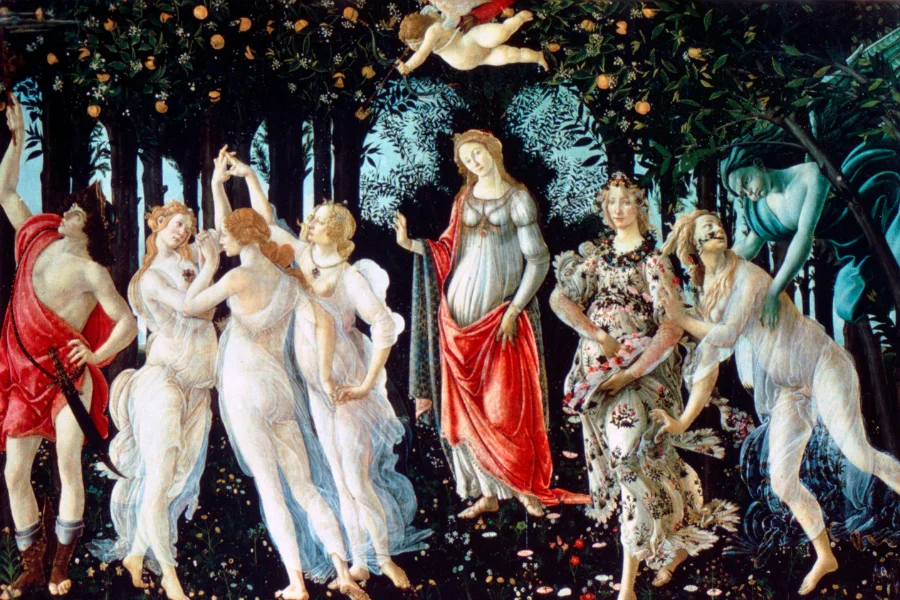
Botticelli’s Primavera presents a vibrant tableau featuring, from left to right, the mythological figures Mercury; the Three Graces; Venus, the goddess of love; the nymph Chloris; Flora, the goddess of fertility, and Zephyr, the west wind. Overhead, Cupid, the god of love, aims the Three Graces with his arrow
Medici family painting commissions marked a turning point in art history. Their support for master artists led to a new wave of innovation, symbolism, and culture in Renaissance Florence.
Botticelli, Leonardo da Vinci, and Michelangelo: Medici-Sponsored Artists
The Medici family influenced the careers of renowned artists such as Botticelli, Leonardo da Vinci, and Michelangelo.
Sandro Botticelli’s “The Birth of Venus” and “Primavera” stand out as Renaissance masterpieces directly funded by Medici patronage.
These works blended mythological themes with new techniques, reflecting the family’s taste and influence on the Florentine art scene.
Leonardo da Vinci also benefited from Medici support. While in Florence, he engaged with Medici intellectual circles and produced early works that explored anatomy and nature.
Michelangelo received commissions from Lorenzo de’ Medici and worked in the Medici Palace’s sculpture workshop, shaping his artistic direction for years.
Their patronage helped establish Florence as a hub of artistic creativity and contributed to lasting transformations in Western art.
Symbolism and Humanism in the Medici Family Painting
Medici family paintings often featured rich symbolism and themes of humanism. Artists included the family’s impresa (emblem), such as the Medici balls, in both religious and secular themes, thereby tying art to the dynasty’s power and legacy.
These works reflected Renaissance ideals, including the value of the individual, the beauty of the human form, and an emphasis on education and learning. Many paintings also highlighted political and cultural connections, using classical references and allegories to celebrate Medici authority.
The family’s support of such themes helped define the new humanist culture of Renaissance Florence. Artistic creativity served both private devotion and public prestige, enhancing the Medici’s reputation as rulers and collectors.
Medici Family Portraits and the Art of Commemoration
Portraits played a key role in the Medici family painting. Artists depicted figures such as Cosimo de’ Medici, Lorenzo de’ Medici, and Medici popes in a dignified and realistic style.
These works recorded the appearance, status, and even health challenges of family members. The paintings served as art and as political tools, reinforcing the Medici dynasty’s influence by displaying portraits in palaces and public buildings.
Through these artworks, the Medici family solidified their legacy as powerful patrons, helping to define the cultural heritage of Florence. Museums like the Uffizi Gallery continue to display these Medici treasures, preserving their role in shaping the arts.
The Enduring Influence of the Medici Family Painting on Art History
The Medici family’s paintings shape the story of Renaissance art through innovation and initiative. Their commissions influenced the subjects depicted in paintings, while their support advanced artistic techniques in Florence and beyond.
Medici Family’s Artistic Heritage in Museums and Restoration
The Medici family’s art legacy remains visible in world-famous museums today. The Uffizi Gallery in Florence houses works such as Botticelli’s “The Birth of Venus,” which is believed to be a commission by the Medici family.
Restoration projects, such as those led by the Opificio delle Pietre Dure, help preserve the authenticity of the Medici family’s paintings. Medici treasures are displayed alongside sculptures, frescoes, and portraits in museums, allowing visitors to experience the dynasty’s influence firsthand.
The family’s role as collectors and patrons made Florence a center for art conservation. Museums around the world work to protect and display these masterpieces, cementing the Medici’s place in art history.
From Religious to Secular Themes in Medici Family Commissions
Medici family commissions signaled a shift from mostly religious artwork to more secular themes during the Renaissance. Earlier paintings featured saints and biblical figures, but Medici patronage expanded this scope.
Botticelli’s mythological scenes, such as “The Birth of Venus,” exemplify classical humanism and symbolism.
The family valued art for its cultural significance and as a means of political influence. Portraits of the Medici, such as those of Lorenzo de’ Medici, became symbols of their wealth and influence.
Through art, they shaped Florence’s culture and signaled their status as rulers and innovators.
The Medici Dynasty’s Contribution to the Birth of the Renaissance
The Medici dynasty’s support for artists like Michelangelo, Leonardo da Vinci, and Donatello fueled a wave of creativity in Renaissance Florence. They provided financial stability, artistic freedom, and workshops for these talents.
Medici family painting commissions gave rise to iconic works that remain at the heart of Western art. Through their cultural influence, accumulation of wealth, and patronage of artists, the Medici sparked innovation in art techniques and disseminated artistic ideas throughout Italy.
Their role in celebrating masterpieces and nurturing artists helped launch the Renaissance and shaped the direction of European art for centuries.
Frequently Asked Questions
The Medici family played a powerful role in the Italian Renaissance by supporting artists and commissioning iconic works. Their wealth and influence drew some of the greatest painters and sculptors of their time to Florence.
What paintings did the Medici family commission?
The Medici family commissioned many masterpieces, including Sandro Botticelli’s “The Birth of Venus” and “Primavera.” They also funded important works by Leonardo da Vinci and Michelangelo.
These commissions significantly influenced the style of Renaissance art in Florence.
What did the Medici family have to do with art?
The Medici family was an important patron of the arts in Florence during the Renaissance. They hired and supported many artists to create paintings, sculptures, and buildings.
Their financial support enabled artists to work full-time, leading to the development of new styles and techniques.
Did Michelangelo paint for the Medici family?
Yes, Michelangelo worked for the Medici family. He designed the Medici Chapel and created famous sculptures like the tombs of Lorenzo and Giuliano de’ Medici.
His early artistic training was sponsored by Lorenzo de’ Medici, who provided him with a place in his palace.
What did Botticelli paint for the Medici family?
Sandro Botticelli painted several works for the Medici family. The most famous include “The Birth of Venus” and “Primavera.”
These paintings were created for their private villas and celebrate themes popular with the family. More information about Botticelli’s Medici commissions can be found in the article on Medici patronage.
Did the Medici family fund Leonardo da Vinci?
The Medici helped Leonardo da Vinci in his early career. They gave him commissions and supported his studies in Florence.
Leonardo worked in workshops that the Medici family used. He established connections that would benefit him later in life.
What famous artists worked for the Medici?
Many famous artists worked for the Medici. This includes Botticelli, Michelangelo, Leonardo da Vinci, Domenico Ghirlandaio, and Andrea del Verrocchio.
The Medici offered them steady work. They supported the growth of these artists.
Who was the most famous member of the Medici family?
Lorenzo de’ Medici, also known as Lorenzo the Magnificent, is the most renowned member of the Medici family. He led Florence and supported the arts.
Who painted the Medici portraits?
Several artists painted portraits of the Medici family. Famous examples include works by Bronzino and Raphael.
These artists captured the likenesses and social status of the family in Renaissance Florence.
What made the Medici family wealthy?
The Medici family amassed its wealth primarily through banking. They ran the Medici Bank, one of the most successful banks in Europe during the 15th century.
Their financial power helped them gain influence in politics and the arts.
What is a four-panel painting called?
Artists refer to a four-panel painting as a “polyptych.” If the artwork has exactly four panels, it may also be called a tetraptych.
During the Renaissance, people often used polyptychs as altarpieces.
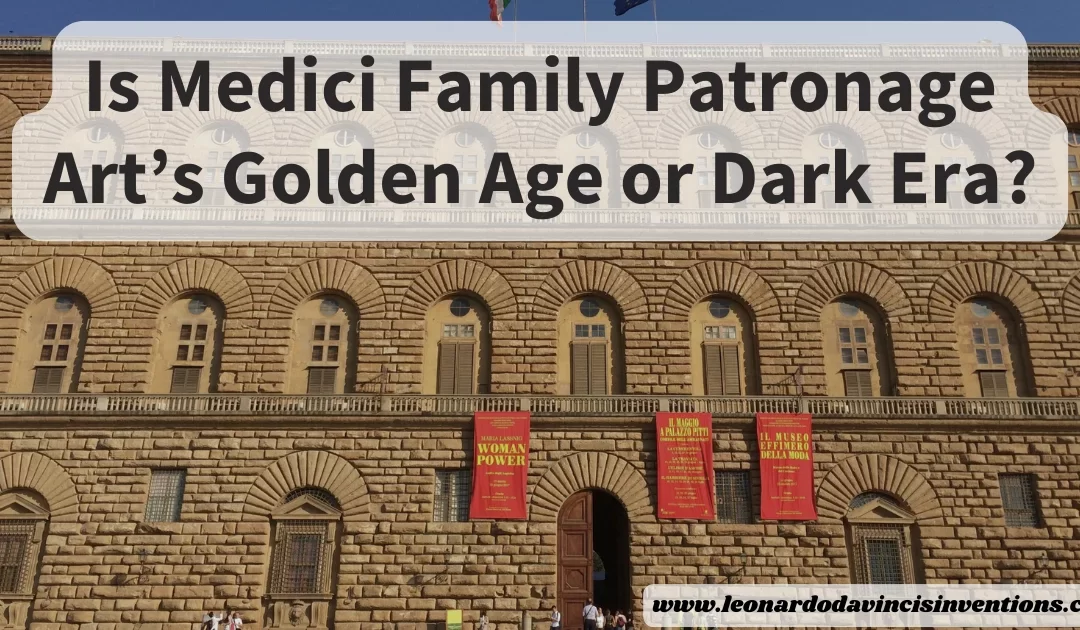
by Dukgyu | Apr 28, 2025 | Renaissance
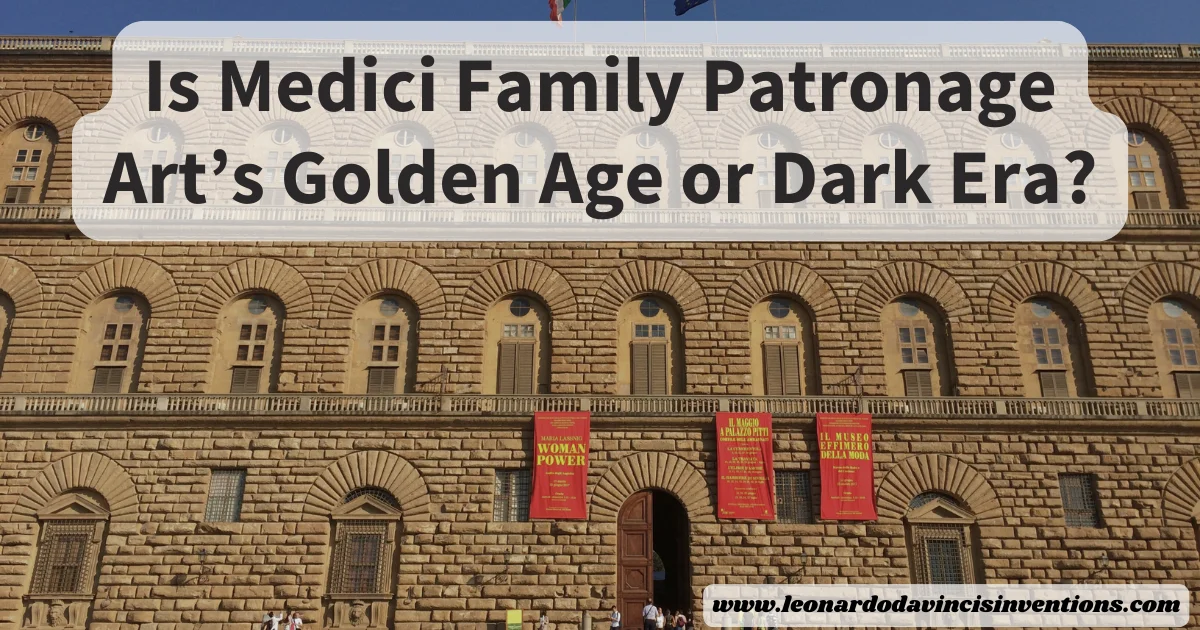
Medici family patronage changed the art world and shaped the Renaissance. The impact is still debated today.
Some people feel lost trying to decide if this support led to art’s golden age or if it created problems that still echo in modern times. You’ll learn about the Medici’s contributions to the arts and how their influence continues to shape people’s perceptions of art and power today.
The Medici became famous for using their wealth to support artists, writers, and thinkers in Florence.
Their patronage enabled many of the most renowned works of Renaissance art, helping to transform Florence into a cultural and creative hub.
This power allowed them to control not only art but also the lives of the people who depended on their approval and money.
The Power and Influence of Medici Family Patronage in Renaissance Florence
Medici family patronage transformed Florence into a thriving cultural and artistic center. The family’s wealth, support of artists, and political strategies raised the city’s reputation throughout Europe.
Banking, Wealth, and the Medici Dynasty’s Rise to Power
The Medici family amassed power through a robust banking empire in Renaissance Florence. This financial network enabled them to accumulate substantial wealth and exert significant influence over commerce across Europe.
They used their banking success to become the unofficial rulers of Florence. Banking provided the Medici family with the means to fund art, architecture, and education.
The dynasty’s growing influence enabled them to commission grand buildings and support the city’s leading scholars and artists. Their wealth also enabled the family to lend money to popes and monarchs.
These connections spread Medici power beyond Florence. The family gained a voice in European politics and the church.
Political Influence Through Art and Patronage
Art as a tool for power played a key role in the Medici influence. By funding Renaissance masterpieces and sponsoring talented artists, the Medici strengthened their social and political position in Florence.
Family figures like Cosimo and Lorenzo de’ Medici supported artists such as Michelangelo, Botticelli, and Leonardo da Vinci. This sponsorship created a unique link between politics and creativity.
Many public works commissioned by the Medici helped promote the family name and ideals. Medici family patronage often acted as propaganda, shaping how citizens viewed their leaders.
The visual splendor of Florence during this period reflected the Medici’s deep investment in both culture and governance.
Patronage and Social Status: Shaping Florentine Society
Patronage and social status were closely connected in Florence. Wealthy Medici family members leveraged their support of artists and intellectuals to gain respect and social standing within society.
Investment in education and learning helped establish Florence as a leading city of humanism and innovation. The Medici shaped cultural history by funding schools, libraries, and churches.
Through their ongoing patronage, the family secured a lasting legacy. Their deep involvement in art, architecture, and religion shaped the identity and social structure of Florence for generations.
Medici Family Patronage of the Arts: Innovation, Legacy, and Controversy

Florence Cathedral, or the Cathedral of Saint Mary of the Flower, is the main church of Florence, Italy
The Medici family’s patronage shaped Florence by investing in art, supporting renowned artists, and influencing both society and politics. The impact of their sponsorship continues to spark debate about the relationship between power, creativity, and legacy.
Funding Renaissance Masterpieces and Artistic Innovation
The Medici family’s wealth from banking enabled them to invest substantial funds in every aspect of Florentine cultural life. They sponsored public sculptures, buildings, and paintings that transformed the city into a center for artistic innovation.
By commissioning works from the best minds, they encouraged creativity and technical progress. Their funding was not limited to visual arts.
The Medici also supported scholars, writers, and scientists, helping promote humanist ideals during the Renaissance. Many projects, such as the dome of Florence Cathedral, demonstrated the connection between art, architecture, and civic pride.
This deep involvement created a Florentine golden age of learning and discovery. For more information on how they supported the arts, see how the Medici family contributed to the Renaissance art movement.
Relationship with Michelangelo, Botticelli, and Leonardo da Vinci
The Medici family formed strong alliances with groundbreaking artists. Michelangelo grew up in their household and received early commissions that helped launch his career.
Medici patronage meant steady work, resources, and a creative environment for both him and his peers. Sandro Botticelli created numerous works for the family, including the famous masterpieces “The Birth of Venus.”
Leonardo da Vinci also worked in Florence, benefiting from the Medici’s social network and political power. These relationships demonstrate how the Medici acted as both art patrons and influencers, shaping taste and trends throughout Italy.
Their support was instrumental in the careers of these legendary artists.
The Legacy of Medici Sponsorship in Art and Politics
The Medici family’s patronage left a profound legacy in both art and political life. By tying art to power, they used masterpieces to reinforce their authority and project nobility.
Their influence reached far beyond Florence, affecting the papacy, education, and even governance across Europe. Medici’s support of artists and scholars shaped society and political structures.
Their sponsorship model set a standard for future rulers and noble families. To explore their impact on culture and politics.
The Dual Impact: Art’s Golden Age or a Dark Era?
Medici family patronage transformed Florence into a powerhouse of creativity, politics, and religion. Support of artists and scholars led to major innovations in art, but also raised questions about power and control during the Renaissance.
Religion, Papacy, and Medici Popes’ Cultural Governance
The Medici family dominated Florence religiously and politically for generations. Their banking empire and wealth gave them unrivaled access to church leadership.
Three Medici became popes—Leo X, Clement VII, and Leo XI—reshaping the role of religion in society and art. Through the Medici popes’ patronage of religion, architects and artists created stunning churches and religious works.
Patronage also brought greater power to the family, solidifying its political influence through art and culture.
Education, Learning, and the Promotion of Humanist Ideals
The Medici family valued humanism, funding Renaissance masterpieces and supporting thinkers like Marsilio Ficino and Pico della Mirandola. Cosimo de’ Medici sponsored the revival of Plato’s works.
Lorenzo de’ Medici backed scholars and artists, including Leonardo da Vinci and Botticelli. This investment helped build educational institutions and libraries in Florence, fostering learning and creative growth.
Education also became a status symbol for nobility. The focus of art and learning shifted from the church to a broader part of society.
The Medici’s Impact on Western Civilization: Innovation or Power and Propaganda?
Under the patronage of the Medici family, Florence experienced a golden age of innovation in painting, sculpture, and architecture. Notable projects, such as Michelangelo’s David and the Florence Cathedral dome, were possible due to Medici sponsorship and investment in commerce.
The dynasty’s use of art as propaganda was clear. By commissioning public works and portraits, the family displayed their wealth, power, and control.
Their sponsorship often blurred the lines between true creativity and political messaging. This led to debates on the Medici’s legacy in shaping cultural history and Western civilization.
Frequently Asked Questions
The Medici family’s patronage transformed art and politics in Renaissance Florence. Their influence shaped the careers of famous artists, strengthened their power, and left a lasting mark on European culture.
What did the Medici family patronage?
The Medici family supported artists, architects, and scholars throughout Florence. They funded the creation of churches, public buildings, sculptures, and paintings, helping to spark the Renaissance.
Their patronage also included libraries, academies, and scientific projects.
Who was commissioned by the Medici family?
Notable artists such as Michelangelo, Botticelli, and Leonardo da Vinci received commissions from the Medicis. They also supported architects like Brunelleschi and Donatello.
Many of these artists created some of their most significant works under the guidance of the Medici.
Who is the patron saint of the Medici?
Saint Lawrence is considered the patron saint of the Medici family. They built the Basilica di San Lorenzo in Florence in his honor.
The church became a burial site for many members of the family.
What result did the Medici hope to achieve with their patronage of the arts?
The Medici family sought to enhance their political influence by fostering the arts. Their investments enhanced Florence’s reputation as a cultural and educational hub.
Patronage also helped display their wealth, taste, and influence to rivals and citizens alike.
Why was the Medici family corrupt?
The Medici family faced accusations of corruption tied to banking, politics, and favoritism. Their use of wealth to gain influence in both the church and government led to criticism.
Some saw their methods as manipulative and self-serving.
How does the Medici family have so much money?
The Medici wealth came from banking and commerce. Their bank was one of the most successful in Europe during the 15th century.
Profitable trade and investments helped the family become leading financiers in Florence and beyond, according to Britannica.
Are there any Medicis alive today?
No direct male descendants of the Medici family remain. The main family line ended in the 18th century.
Some people claim distant connections, but there are no current heirs to the Medici name or fortune.
What did the Medici serve as patrons?
The Medici acted as patrons to painters, sculptors, architects, and scholars. They supported the building of churches, public spaces, and art collections.
Their support helped make Florence a major cultural center in the Renaissance, as discussed by the Smithsonian Associates.
How did patronage affect the Renaissance?
Medici patronage led to the creation of many masterpieces. It allowed artists to work on ambitious projects and experiment with new techniques.
The culture of patronage also fostered competition between artists and helped spread Renaissance ideas throughout Europe.
How did the Pope reward the Medici?
Members of the Medici family received important positions within the Catholic Church.
Some became popes themselves, such as Leo X and Clement VII.
These roles gave the family more power and influence in both religious and political affairs.

by Dukgyu | Apr 28, 2025 | Renaissance

Medici family definition in world history can be confusing, especially if you feel unsure about what you’ve learned.
You may wonder if the standard definition tells the real story or scratches the surface. This article aims to clarify the confusion and provide facts supported by historical research.
The Medici family was an Italian banking dynasty and a political powerhouse that ruled Florence for centuries, leaving a profound impact on both the city and Europe.
Their influence extended not only to wealth and politics but also to support for artists and thinkers during the Renaissance. To see how this powerful family shaped history, take a closer look at their legacy, leadership, and lasting impact on Florence and Tuscany.
Medici Family Definition World History, and Their Rise to Power
Medici family definition in world history centers on their transformation from merchants to rulers and how their banking empire gave them lasting influence.
Their story highlights Florence’s shift from a republic to a political dynasty with deep roots in European society.
From Merchants to Rulers of Florence and Tuscany
The Medici family began as merchants in Florence, Italy, during the late Middle Ages.
Through smart trading and business deals, they steadily increased their wealth.
By the 15th century, the Medici became powerful enough to influence public affairs and eventually took over as rulers of Florence.
Cosimo de’ Medici became the unofficial leader in 1434, marking the beginning of the family’s path to ruling both Florence and, later, Tuscany.
The Medici Bank and Economic Power in Renaissance Italy
The Medici Bank played a key role in the family’s rise to power.
It was one of the largest and most respected banks in Europe during the Renaissance. They managed the finances of the Catholic Church, European royals, and wealthy merchants.
With this banking success, the Medici gained not just wealth but also influence in international trade and politics.
The Medici’s economic strength allowed them to support art, science, and architecture in Florence, cementing their reputation as key patrons of the Renaissance.
Political Dynasty and Control Over Florentine Government
As their fortune grew, the Medici family became a true political dynasty.
They held absolute control over the Florentine government, even when the city remained a republic by name. Key family members held high offices and used their positions to expand their family’s power.
Their rule faced opposition, but their strong alliances and wealth helped them survive.
Over time, several members of the Medici family became dukes and even popes, further expanding their legacy and influence in world history.
Medici Family: Definition, Role in World History, and Cultural Influence
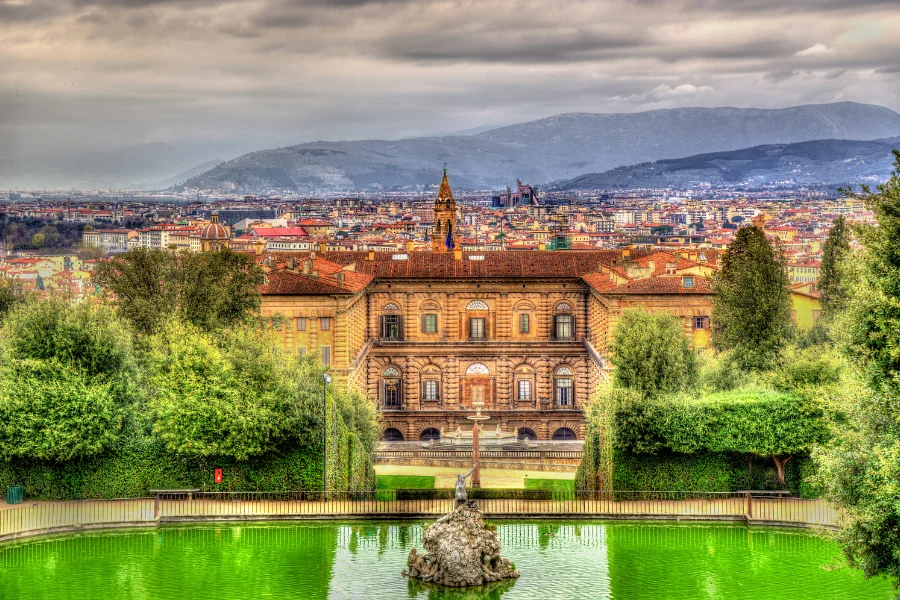
The Palazzo Pitti, or Pitti Palace, is a large Renaissance palace in Florence, Italy
The Medici family definition in world history centers on a powerful Italian banking family that became the rulers of Florence and Tuscany.
Their influence extended deeply into art, government, and the economy, making them pivotal figures during the Renaissance.
Patronage of Art, Science, and the Renaissance
The Medici family used their wealth and power from banking to support artists, architects, and scientists.
As rulers of Florence, they financed famous works by Leonardo da Vinci, Michelangelo, and Botticelli.
This patronage turned Florence into a hub of innovation and creativity during the Renaissance.
The Medici encouraged not only art and architecture but also scholarship, thereby helping to spread humanist ideas.
Their support for libraries and scientific research advanced learning across Europe.
The Medici influence on art and science changed Europe’s cultural history forever.
Medici Legacy as Supporters of Artists and Intellectuals
The Medici legacy stands on the achievements of the thinkers and creators they supported.
Their sponsorship enabled painters, sculptors, and writers to push boundaries and create works that profoundly shaped Western civilization.
The family nurtured visual artists and aided scientists like Galileo, offering him protection when his ideas were challenged.
Several Medici popes and princes elevated Florence by building churches and public spaces filled with masterpieces.
This connection between the Medici and creative minds drove much of the progress during the Renaissance.
The Medici family’s definition in world history is closely tied to their role as supporters of innovation and culture.
Medici and Tuscany: Shaping Society, Nobility, and Heritage
From their rise to power in the 15th century, the Medici established themselves as political leaders, transforming Florence from a republic to a duchy under their control.
Their rule lasted for hundreds of years, bringing stability even as it encouraged the growth of trade and the arts.
The Medici became dukes and married into many of Europe’s royal families, strengthening their influence.
They changed the social structure of Tuscany, raising their court to the level of nobility.
Their legacy, seen in Florence’s architecture and art, continues to define the heritage and society of Tuscany today.
Medici Family Definition World History: Truths, Myths, and Legacy
The Medici family definition in world history highlights the mix of facts and legends that have surrounded this Italian banking family.
Their influence on Renaissance Italy, politics, art, and culture shaped both Florence and Europe for centuries.
Medici Popes, Dukes, Princes, and Their Lasting Impact
The House of Medici produced leaders who altered the course of Italian and, by extension, European history.
At the height of their power, the family included popes such as Leo X and Clement VII, as well as rulers like Cosimo I, who became the Grand Duke of Tuscany.
They gained their wealth through the Medici bank, which became one of the most powerful financial institutions in Europe during the 15th century.
As supporters of the arts, the Medici family sponsored artists such as Michelangelo, Botticelli, and Leonardo da Vinci. Their support helped trigger the Italian Renaissance and left a significant mark on art, science, and culture.
Their legacy is still evident in the palaces and artworks of Florence, as well as in the enduring influence of Renaissance values.
The Fall of the Medici and Their Place in World History
The Medici dynasty’s grip on Florence and Tuscany weakened over time due to internal power struggles, growing opposition, and shifting European political dynamics.
In the 18th century, the family line died out, bringing an end to their long rule over Tuscany.
Despite their fall, the Medici legacy in politics, economics, and culture continues to be important in world history.
The family’s rise and decline reflect how merchants could become nobles, shift the economy, and drive European history.
Medici stories encompass tales of intrigue, corruption, and patronage, but many facts are derived from public records and contemporary writers.
Medici Family Tree, Contributions, and Historical Significance
The Medici family tree originated from merchants and bankers in Florence, evolving into a dynasty of rulers, dukes, and popes that shaped Italy’s government and society.
Over nearly 300 years, the family supported scholars and artists, advanced science, and influenced political trends.
Major contributions from the Medici included funding cathedrals, libraries, and universities.
Their policy of cultural patronage fueled advancements in many fields.
The Medici family’s definition in world history is best understood as a blend of myth and recorded achievement, central to the understanding of Renaissance Florence and Tuscany, as well as the broader legacy of Italian banking families.
Frequently Asked Questions
The Medici family played a major role in banking and politics in Florence, Italy, from the 15th to the 18th century.
Their story encompasses significant influence, substantial wealth, notable contributions to art and science, as well as scandals and controversy.
What is the Medici family short definition?
The Medici family was a wealthy and influential Italian banking family that rose to power in Florence during the Renaissance.
They shaped politics, business, and culture for centuries.
Who were the Medici, and why are they important?
The Medici were a powerful family of bankers and political leaders in Florence.
They supported artists like Michelangelo and Leonardo da Vinci, which helped initiate the Renaissance.
Their legacy is tied to advancements in art, science, and government across Europe.
What was the Medici family’s wealth worth in today’s currency?
Exact numbers are difficult to estimate, but historians agree that the Medici family was among the wealthiest individuals in Renaissance Europe.
Their wealth today would likely be in the billions, comparable to that of the wealthiest families or companies in the modern world.
What was the dark side of the Medici family?
The Medici were involved in power struggles, conspiracies, and sometimes violence.
They used their influence to control politics, sometimes exiling or harming rivals. There were multiple assassination plots, including the famous Pazzi Conspiracy.
What is the short history of the Medici family?
The family gained power through banking in the 1400s.
They ruled Florence for hundreds of years, except for brief periods of interruption.
The Medici lost control in the 1700s when the last member of the family died without an heir.
Who was the most powerful family in Italy?
During the Renaissance, the Medici family was one of the most powerful families in Italy.
Their control over Florence, along with their connections to banks, politics, and the church, made them major players in European history.
Who was the most famous Medici?
Lorenzo de’ Medici, also called Lorenzo the Magnificent, is the most famous family member.
He was known for his political skills, support of the arts, and leadership in Florence.
Cosimo de’ Medici, the family’s founder, is also well known.
What caused the Medici downfall?
Their decline stemmed from a combination of poor financial decisions, the lack of strong heirs, and shifting political tides in Europe.
By the 18th century, their political power had waned, and the family line came to an end with Anna Maria Ludovica’s death in 1743.
Is the Medici a royal family?
The Medici became grand dukes of Tuscany and married into royal families; however, they were not born into royalty.
They rose from merchants and bankers to nobility by gaining titles through power and wealth.
Does the Medici family still exist today?
The main Medici family line ended in the 1700s. Today, no direct descendants hold significant titles or influence.















 I’m Leonardo Bianchi, the mind behind Leonardo da Vinci's Inventions. Thanks for visiting.
I’m Leonardo Bianchi, the mind behind Leonardo da Vinci's Inventions. Thanks for visiting. 
